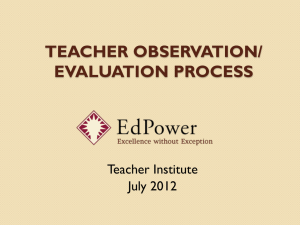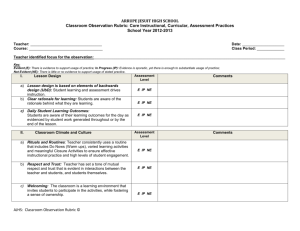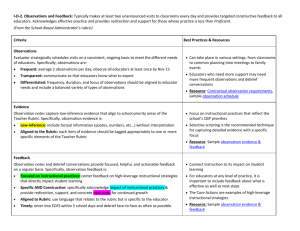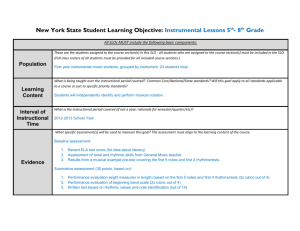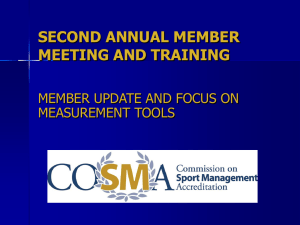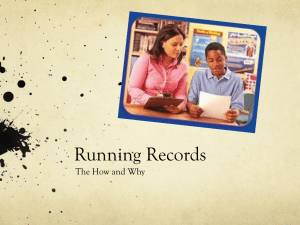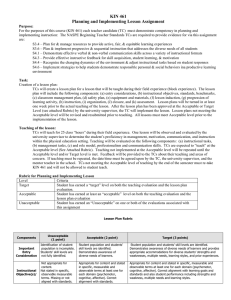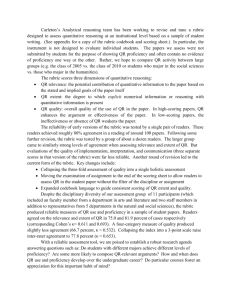New York State Student Learning Objective Template
advertisement
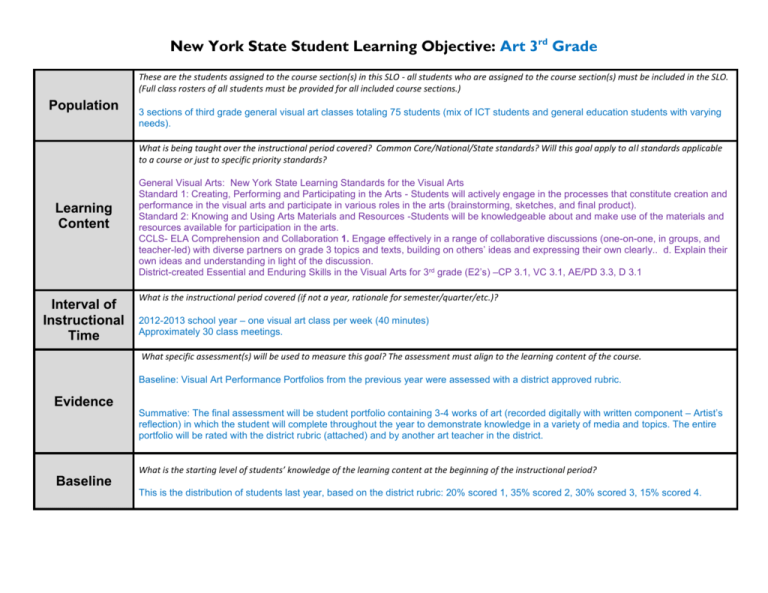
New York State Student Learning Objective: Art 3rd Grade These are the students assigned to the course section(s) in this SLO - all students who are assigned to the course section(s) must be included in the SLO. (Full class rosters of all students must be provided for all included course sections.) Population 3 sections of third grade general visual art classes totaling 75 students (mix of ICT students and general education students with varying needs). What is being taught over the instructional period covered? Common Core/National/State standards? Will this goal apply to all standards applicable to a course or just to specific priority standards? Learning Content Interval of Instructional Time General Visual Arts: New York State Learning Standards for the Visual Arts Standard 1: Creating, Performing and Participating in the Arts - Students will actively engage in the processes that constitute creation and performance in the visual arts and participate in various roles in the arts (brainstorming, sketches, and final product). Standard 2: Knowing and Using Arts Materials and Resources -Students will be knowledgeable about and make use of the materials and resources available for participation in the arts. CCLS- ELA Comprehension and Collaboration 1. Engage effectively in a range of collaborative discussions (one-on-one, in groups, and teacher-led) with diverse partners on grade 3 topics and texts, building on others’ ideas and expressing their own clearly.. d. Explain their own ideas and understanding in light of the discussion. District-created Essential and Enduring Skills in the Visual Arts for 3rd grade (E2’s) –CP 3.1, VC 3.1, AE/PD 3.3, D 3.1 What is the instructional period covered (if not a year, rationale for semester/quarter/etc.)? 2012-2013 school year – one visual art class per week (40 minutes) Approximately 30 class meetings. What specific assessment(s) will be used to measure this goal? The assessment must align to the learning content of the course. Baseline: Visual Art Performance Portfolios from the previous year were assessed with a district approved rubric. Evidence Summative: The final assessment will be student portfolio containing 3-4 works of art (recorded digitally with written component – Artist’s reflection) in which the student will complete throughout the year to demonstrate knowledge in a variety of media and topics. The entire portfolio will be rated with the district rubric (attached) and by another art teacher in the district. What is the starting level of students’ knowledge of the learning content at the beginning of the instructional period? Baseline This is the distribution of students last year, based on the district rubric: 20% scored 1, 35% scored 2, 30% scored 3, 15% scored 4. Target(s) What is the expected outcome (target) of students’ level of knowledge of the learning content at the end of the instructional period? 80% of the students will earn a level three or four on the performance task rubric (attached). How will evaluators determine what range of student performance “meets” the goal (effective) versus “well-below” (ineffective), “below” (developing), and “well-above” (highly effective)? See below (based on baseline data and district history): HEDI Scoring HIGHLY EFFECTIVE EFFECTIVE DEVELOPING INEFFECTIVE 20 19 18 17 16 15 14 13 12 11 10 9 8 7 6 5 4 3 2 1 0 99100 9798 9596 9294 8891 8587 8284 7981 7678 7375 7172 6870 6467 6063 5759 5356 4952 4548 4044 3039 <30 % Describe the reasoning behind the choices regarding learning content, evidence, and target and how they will be used together to prepare students for future growth and development in subsequent grades/courses, as well as college and career readiness. Rationale The Learning Content is based on essential skills that 3rd graders will need to know before they move on to the next grade level. The visual art curriculum is sequential and builds upon/ repeats skills and knowledge in the arts. These skills and experiences (both hands on and through verbal and written critique) will aid in other subject areas as well as 7/8 art. Student work will assessed with a rubric that focuses on specific skills and visual evidence of application of concepts. The rating scale on the rubrics is 1-4 (aligning with the ELA scoring scale). Sample Rubric for Assessing Student Portfolios at the Elementary Level* Objectives or Performance Criteria Level 4 Level 3 Level 2 Level 1 Understands and applies the elements of art Most items demonstrate excellent understanding and application of the elements of art with a focus on color, line, and space. Some items demonstrate basic understanding and application of the elements of art showing some knowledge and application of color, line and space. Errors often observed in understanding and limited application of the elements of art: color, line, or space. Unable to demonstrate basic understanding of the elements of art. Understands and applies the arts principles Most items demonstrate excellent understanding and application of arts principles mainly repetition and balance. Some items demonstrate basic understanding and application of arts principles such as repetition and balance. Errors often observed in understanding and limited application of the arts principles repetition and balance. Unable to demonstrate basic understanding of arts principles. Displays proficiency in techniques / skill development Techniques/skills consistently applied in accurate and expressive manner, often going beyond what is expected. Some degree of proficiency of skills/techniques observed, but requires additional work in a few key areas. Proficiency of skills/ techniques is lacking in many key areas. There has been little or no skill development. Reflects on own work and learning Clearly discusses or explains in writing why choices were made and describes with insight what did or did not work. Can describe some key aspects of decision-making and problemsolving process. Has difficulty describing his/her own creative process. No attempt or interest in reflecting on development of own work. Demonstrates cultural and historical interest and understanding High degree of interest in cultural and historical contexts (e.g., eager to learn about a wide range of artists, their lives, and their work). Often demonstrates interest in cultural and historical contexts (e.g., demonstrates an interest in learning about architecture from various time periods). Limited interest in cultural and historical contexts (e.g., recognizes that Ukrainian and First Nation and Métis dances are not the same). No interest in cultural and historical contexts (e.g., does not listen or contribute to discussions on this topic). Includes a variety of items or projects in portfolio Includes items that reflect a wide range of skills and understanding. Includes items that reflect some variety of skills and understanding. Two or three items reflect variety of learning. Items included demonstrate very little variety. *Adapted from New York State Art Teachers Association Portfolio Project format (http://www.nysata.org/portfolio-project)
